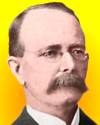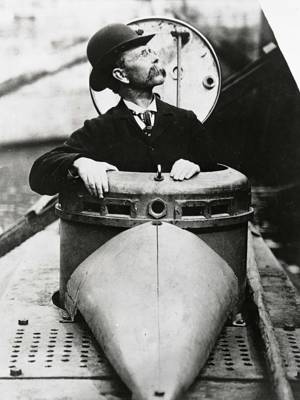 (source)
(source)
|
John Philip Holland
(29 Feb 1840 - 12 Aug 1914)
Irish inventor who has been called the “father of the modern submarine.” He designed and built the first successful submarine, Fenian Ram (1875). After improvements, he received a contract from by the U.S. Navy (1895).
|
THE INVENTOR OF THE SUBMARINE
JOHN PHILIP HOLLAND
From Our Foreign-born Citizens: What They Have Done for America (1922)
By Annie E.S. Beard
[p.149] IF EVER a man persevered in spite of repeated discouragements it surely was John Philip Holland, but he won out at last when his model of a submarine was accepted as the standard of the United States Navy. It was another instance of this country being indebted to a foreign-born citizen for something of real value.
John Philip Holland was born at Liscannor, County Clare, Ireland. He received his education in the Christian Brothers’ Schools in Ennistymon and Limerick. His father’s death obliged his going to work and he did so in a tobacco shop. In 1858 he aspired to something higher and became an instructor in the school in which he was educated, but his health failing, he was transferred to a school in Waterford in hope that he would be benefited. Then still not in good health, he went to Cork. Soon after, the Civil War started in the United States and the naval battle between the Monitor and the Merrimac turned his thoughts to some way of [p.150] combatting such ships. His father having been a coastguard naturally gave his son a love for the sea and all connected with it. So he studied and thought of the possible means of overcoming an ironclad ship, and the idea of a submarine first came to him. He did not give it up but commenced a systematic study of the subject. In 1863-4 he drew his first plan of an under water boat.
But his ideas were too novel for him to be able to secure the necessary financial backing for the carrying out of his plan. He therefore abandoned further effort for awhile, although he continued to study the matter and continued his teaching.
In 1873 he came to the United States, settling at first in Boston where an accident by falling on the ice confined him for some time to the hospital. This gave him a chance to devote his mind again to the subject of the submarine. He was accustomed to say that this accident was the luckiest thing that ever happened to him, for it gave him opportunity to discover and remove some defects in his original plans for a submarine and aided greatly the ultimate success of his device.
Holland was an ardent Irish patriot and his submarine plans were made largely with the purpose of reducing England’s sea power. His [p.151] first attempt to build the boat he planned was made at Patterson, N. J., where he went to teach in St. John’s Parochial School. Old residents of the city long remembered the curious sight that passed along the streets. On a truck was a cigar-shaped boat drawn by sixteen Rogers’ locomotive horses to the Passaic River. It certainly was not a success, for it stuck in the mud when it was launched; it leaked constantly; and the petroleum engine broke down frequently. It was generally regarded as a joke. Finally Holland himself towed it out and sunk it in four feet of mud off Lister’s boathouse.
It was a discouraging result, but nothing daunted, Holland set to work at once on plans for a second boat, endeavoring to profit from the defects of the first one. The Fenian Skirmishing Fund was raised by Irish patriots in America for the purpose of aiding their native land, and sympathizing with Holland’s idea of combatting England, they furnished him with the financial backing he needed, although he was not himself a Fenian. This boat was an advance over his first one, because it was built on correct principles; it sailed more easily; it stayed under water in the desired position; the operator had no difficulty in breathing, and the compressed air chambers worked exactly as wanted. But it was not a perfect boat as the machinery was badly placed. [p.152] A newspaper reporter named it the Fenian Ram and the name pleasing Holland, he adopted it.
Financial troubles now annoyed him, nevertheless he built a third submarine at Fort Hamilton, but unfortunately it was wrecked in launching by a collapse of the ways. This hindered his doing anything further for awhile, but he continued to endeavor to interest the United States government in his submarine plans. Then the Navy Department began to investigate the subject and in 1888 asked for designs. The Holland Company, which had been formed, submitted those of Mr. Holland, but neither his nor those of any other competitor were accepted at this time, although Holland’s were unanimously declared to be the best. In 1893 the Navy again asked for designs, and in competition with nine others, those of John Philip Holland were accepted and a contract was given him. To comply with this order he started to build the Plunger but it was never completed as improvements were contemplated.
Another was built at the company’s own expense and named the Holland; it was fitted with gas engines instead of those run by steam, and it proved to be the first really successful submarine. It was accepted by the United United States Navy as its standard in 1900. It was only fifty feet long and carried only one torpedo tube. It came to the surface quickly to take observations and took only five seconds to disappear, dropping below the waves before an enemy could fire a shot. Mr. Holland is said to have taken the porpoise as his diving model. In the manoeuvres off Newport when it was tested, everything worked most satisfactorily. The warships knew this new strange vessel was after them and they had their searchlights out, but they failed to discover her, yet she sailed up to the New York and fired an imaginary torpedo at her, and she did likewise with the Kearsage.
Admiral Dewey said, on witnessing the performance, “If they had had that sort of thing at Manila, I never could have held it with the squadron I had. The moral effect is immense. It is wholly superior to mines or torpedoes.”
The government ordered more submarines at once. After all his disappointments, Holland had at last won, and proved his faith by his works. Others had preceded him in attempts to make a submarine, notably David Bushnell and Robert Fulton, but Holland was the first to make the idea really work. Arrangements were made by England to purchase the rights to all his patents, and since then, the English submarines have been developed from Holland’s designs. Austria also built many for other countries under a license from him.
Holland benefited this land by giving it the means to protect her coasts against all attacks of her enemies. A fleet of submarines on each coast would effectually keep this country from bombardment by foreign ships of war.
- 29 Feb - short biography, births, deaths and events on date of Holland's birth.
- Mr. Holland’s Little Demon - Newspaper article (1883) on Holland’s early submarine.
- John P. Holland, 1841-1914: Inventor of the Modern Submarine, by Richard Knowles Morris. - book suggestion.





